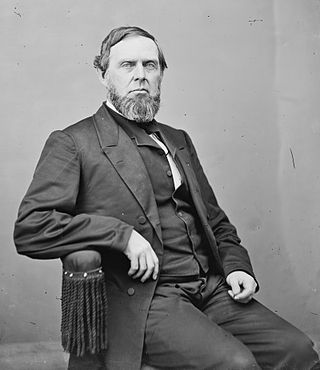
James Harlan was an attorney and politician, a member of the United States Senate, a U.S. Cabinet Secretary at the United States Department of Interior under President Andrew Johnson, and a Federal Judge.
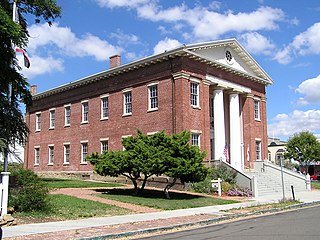
Benicia Capitol State Historic Park is a state park in Benicia, California, United States. The park is dedicated to California's third capitol building, where the California State Legislature convened from February 3, 1853, to February 24, 1854, when they voted to move the state capital to Sacramento. It is the only pre-Sacramento capitol that remains. The park includes the Fischer-Hanlon House, an early Benicia building that was moved to the property and converted into a home in 1858, after the legislature departed. Benicia Capitol State Historic Park just off the city's main street also includes a carriage house, workers' quarters and sculptured gardens.

John Middleton Clayton was an American lawyer and politician from Delaware. He was a member of the Whig Party who served in the Delaware General Assembly, and as U.S. Senator from Delaware and U.S. Secretary of State.

Old Sacramento State Historic Park occupies around one third of the property within the Old Sacramento Historic District of Sacramento, California. The Old Sacramento Historic District is a U.S. National Historic Landmark District. The Historic District is sometimes abbreviated as Old Sacramento, or Old Sac, and since the 1960s has been restored and developed as a significant tourist attraction.

John Neely Johnson was an American lawyer and politician. He was elected as the fourth governor of California from 1856 to 1858, and later appointed justice to the Nevada Supreme Court from 1867 to 1871. As a member of the American Party, Johnson remains one of only two members of a third party to be elected to the California governorship.
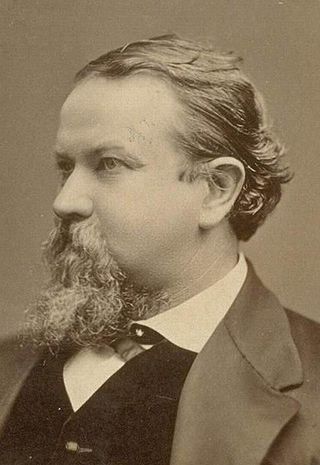
Milton Slocum Latham was an American politician, who served as the sixth governor of California and as a U.S. Representative and U.S. Senator. Latham holds the distinction of having the shortest governorship in California history, lasting for five days between January 9 and January 14, 1860. A Lecompton Democrat, Latham resigned from office after being elected by the state legislature to a seat in the U.S. Senate.
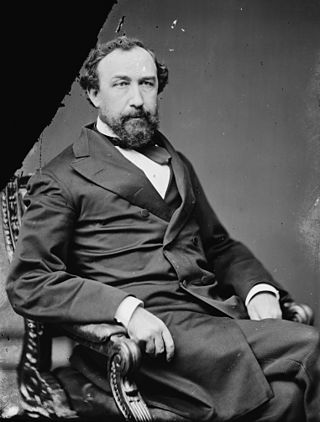
Newton Booth was an American entrepreneur and politician who served as the 11th governor of California from 1871 to 1875 and as U.S. Senator from California from 1875 to 1881. He was the only member of the Anti-Monopoly Party elected to the U.S. Senate.

John Bigler was an American lawyer, politician and diplomat. A Democrat, he served as the third governor of California from 1852 to 1856 and was the first California governor to complete an entire term in office, as well as the first to win re-election. His younger brother, William Bigler, was elected governor of Pennsylvania during the same period. Bigler was also appointed by President James Buchanan as the U.S. Minister to Chile from 1857 to 1861.

The Leland Stanford Mansion, often known simply as the Stanford Mansion, is a historic mansion and California State Park in Sacramento, California, which serves as the official reception center for the Californian government and as one of the official workplaces of the governor of California.

James Taylor Lewis was an American lawyer and politician who served as the 9th Governor of Wisconsin (1864–1866). Prior to his election as governor, he was the 7th Secretary of State of Wisconsin (1862–1864) and the 4th Lieutenant Governor of Wisconsin (1854–1856), and served one year each in the Wisconsin State Senate (1853) and Assembly (1852).

Robert Francis Morrison was the 13th Chief Justice of California from November 1879 to March 2, 1887, when he died in office.

William Thompson Wallace was the 12th Chief Justice of California and the 6th Attorney General of California. He served on the Supreme Court of California from 1871 to 1879 and as Attorney General from 1856 to 1858.

The Pony Express Terminal, also known as the B. F. Hastings Bank Building, is a historic commercial building at 1000 2nd Street in Sacramento, California. Built in 1852, it was the western endpoint of the Pony Express from 1860 to 1861, the period of the service's operation. It was declared a National Historic Landmark in 1966. It now houses a museum dedicated to the history of Wells Fargo, and is part of Old Sacramento State Historic Park, itself a National Historic Landmark District. The B. F. Hastings Bank Building is a California Historical Landmark No. 606.

The California Governor's Mansion is the official residence of the governor of California, located in Sacramento, the capital of California. Built in 1877, the estate was purchased by the State of California in 1903 and has served as the executive residence for 14 governors. The mansion was occupied by governors between 1903–1967 and 2015–2019. Since 1967, the mansion has been managed by California State Parks as the Governor's Mansion State Historic Park.

The Varner–Hogg Plantation State Historic Site is a historical site operated by the Texas Historical Commission. The site was the home of former Governor of Texas James S. Hogg and his family. The site is located outside West Columbia, in Brazoria County.

The Sacramento Historic City Cemetery, located at 1000 Broadway, at 10th Street, is the oldest existing cemetery in Sacramento, California. It was designed to resemble a Victorian garden and sections that are not located in level areas are surrounded by brick or concrete retaining walls to create level terraces. The cemetery grounds are noted for their roses which are said to be among the finest in California.
Charles Henry Bryan was a politician and jurist in California, who served as an associate justice of the California Supreme Court.

James Dabney Thornton was an American lawyer and judge who served as associate justice of the Supreme Court of California from 1880 to 1891.
Mary Johnson was the 4th First Lady of California, wife of J. Neely Johnson, Governor from 1856 to 1858.
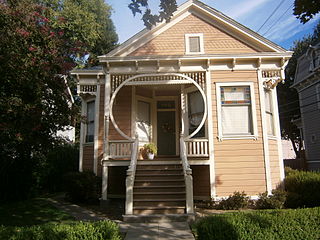
The Alkali Flat Historic District is a historic district in Sacramento, California. It is the oldest surviving neighborhood in Sacramento. The older Alkali Flat buildings and homes were built between 1853 and 1869 by the Sacramento's upper class. Alkali Flat borders are: 12th Street, H Street, 7th Street, and Southern Pacific Train tracks to the north.
























